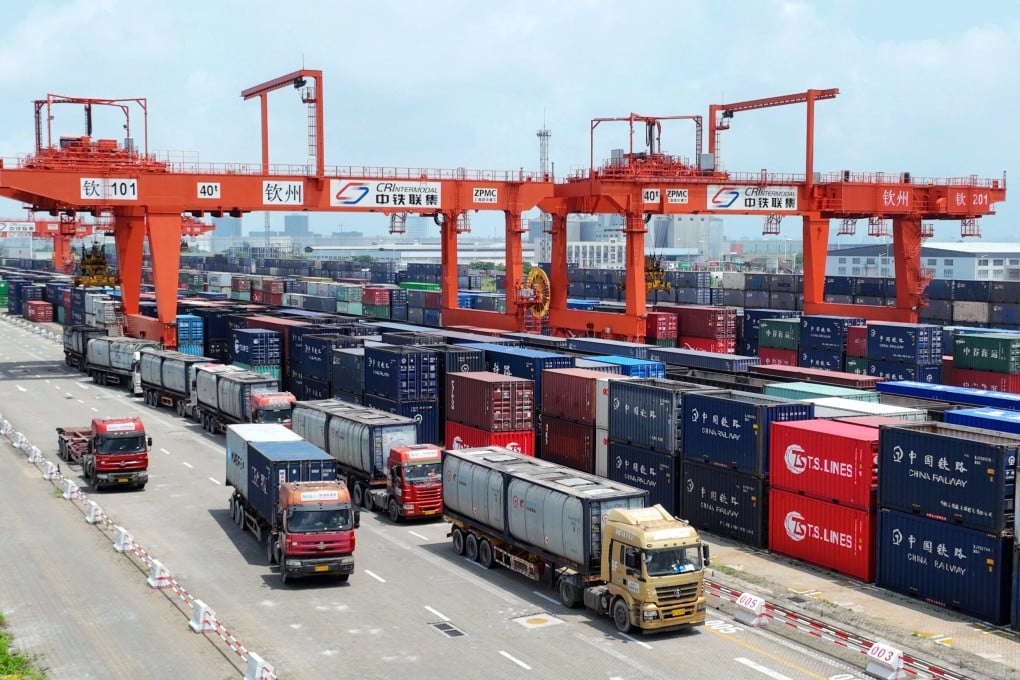China’s Exports to U.S. Set to Plunge by $485 Billion by 2027 Amid Tariff Surge, Simulator Forecasts
China’s Exports to U.S. Set to Plunge by $485 Billion by 2027 Amid Tariff Surge, Simulator Forecasts
By
Leah Rosenfeld
Last updated:
July 29, 2025
First Published:
August 6, 2025

Photo: South China Morning Post
Sharp Decline Forecasted in China-U.S. Trade Over Next Three Years
A recent global trade simulation conducted by the Observatory of Economic Complexity (OEC) predicts that Chinese exports to the United States could drop by a staggering $485 billion by 2027 if current tariff policies persist. This forecast underscores the profound impact ongoing trade tensions and tariff escalations have on global commerce.
In contrast, U.S. exports to China are expected to decline by approximately $101 billion during the same period, reflecting reciprocal trade pressures and shifting global market dynamics.
Tariff Landscape: Current Rates and Possible Escalations
Currently, the U.S. imposes an average 51% tariff on Chinese goods, while China levies tariffs averaging 32.6% on American products. The potential for these tariffs to surge further—up to an alarming 145% on Chinese imports if no agreement is reached by the August 12 deadline—threatens to exacerbate the trade imbalance and disrupt supply chains worldwide.
U.S. government data indicates that in 2024, Chinese goods imported into the U.S. totaled around $438.9 billion, serving as a baseline for the projected decline.
Global Trade Realignment: Winners and Losers
The OEC’s tariff simulator reveals that as China’s exports to the U.S. contract, other countries are positioned to capitalize on the shifting landscape:
- Russia is projected to secure the largest share of new trade with China, gaining approximately $69.8 billion.
- Vietnam and South Korea, traditionally linked with China through manufacturing supply chains, are forecasted to see their U.S. exports shrink by $102 billion and $49 billion respectively.
- The U.S. is anticipated to increase imports from Canada (+$128 billion), Mexico (+$77 billion), and the United Kingdom (+$23 billion), supported by recent trade agreements.
Sector-Specific Impact: Key Product Declines
Certain industries face significant downturns due to tariffs:
- Chinese broadcasting equipment and computers could see declines of $59.2 billion and $58.7 billion respectively in U.S. exports.
- South Korean automotive exports to the U.S. are projected to fall by $13.5 billion.
- On the American side, major export losses to China include soybeans (-$10 billion), integrated circuits (-$7.44 billion), crude petroleum (-$7.33 billion), petroleum gas (-$6.36 billion), and vehicles (-$5.09 billion).
Real-Time Indicators: Shipping Trends Reflect Trade Shifts
Data from the Port of Los Angeles and other ocean freight sources indicate a tangible decline in container shipments from China to the U.S. after an initial spike in early July, driven by pre-tariff stockpiling. Vessel arrivals have dropped from 66.8 ships per day to around 58.7, signaling a contraction in trade volume.
Retail giants such as Ikea, Walmart, Costco, and Amazon heavily rely on Chinese imports. Ikea leads with 14.6% of shipments originating from China, primarily furniture, while Walmart imports significant quantities of light synthetic cotton fabrics (64%).
Regional Impacts Within the U.S.
The trade slowdown will disproportionately affect certain U.S. states:
- Texas tops exports to China at $954 million, mainly electrical machinery, mineral fuels, and machinery parts.
- California and Oregon follow with $179 million and $458 million in exports respectively, focused on optical equipment, electronics, and machinery.
Expert Perspective: The Future of Global Trade Amid Protectionism
Former U.S. Commerce Secretary Carlos Gutierrez commented on the ongoing disruptions, emphasizing the transient nature of current trade conflicts but warning against protectionism’s longer-term risks. “Protectionism doesn’t protect. It strips a nation of its vitality,” he noted during a CNBC interview.
The evolving tariff environment between the U.S. and China is triggering significant trade realignments, with profound consequences for exporters, manufacturers, and consumers globally. While China’s export dominance faces unprecedented challenges, new trading partnerships are emerging as nations recalibrate in this volatile landscape.
Understanding these dynamics will be crucial for policymakers and businesses aiming to navigate the uncertain waters of 21st-century global trade.
Popular articles
Subscribe to unlock premium content
Disney’s Timeless Magic and How the Entertainment Giant Continues to Shape Culture and Innovation

Imran Khan’s Economic Missteps Amid Political Chaos in Pakistan

The Philippines’ Digital Shift How Remittances and BPO Are Fueling Growth

Disney’s Timeless Magic and How the Entertainment Giant Continues to Shape Culture and Innovation

Imran Khan’s Economic Missteps Amid Political Chaos in Pakistan

Disney’s Timeless Magic and How the Entertainment Giant Continues to Shape Culture and Innovation









